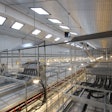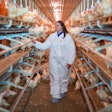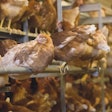The battle is raging over the future of battery cages for the layer business, and it's too early to call who the victor will be. On the one side are powerful animal rights groups such as the Humane Society of the United States (HSUS), which are pressing for an all-out ban on the use of battery cages through legislative efforts and pressuring the marketplace to buy only cage-free eggs.
"The egg industry is completely out of step with American's expectations of how animals ought to be treated," says Paul Shapiro, the HSUS's director of the factory farming campaign. "What the industry needs to do," he says, "is to get rid of battery cages." He cites the recent move by Burger King, Wolfgang Puck, and others, in painting a picture of a marketplace responding to consumer wishes for more cage-free egg production.
Fear of Retaliation
But in the view of Gene Gregory, president and CEO of the United Egg Producers, Altanta, the switch of egg buyers in the marketplace to cage-free is "not at all" due to consumer pressure against battery cages. Rather, he says, companies are making changes in their egg procurement policies "because they are afraid of what they (animal rights groups) might do to them if they don't. They don't want to be retaliated against." In some cases, Gregory says, companies that have switched to cage-free have called United Egg Producers (UEP) and apologized for doing so.
Gregory says the HSUS, Farm Sanctuary, and People for the Ethical Treatment of Animals (PETA) "are aggressively trying to force everyone to buy cage-free eggs and they're getting more aggressive all the time." He says he is not opposed to cage-free, and UEP represents producers of cage-free, in addition to organic and conventional producers of battery cage production. But that said, Gregory believes in consumer choice; consumers should have the right to buy whatever eggs they want rather than be forced to a specific purchase.
Gregory's view is that animal care standards should be science-based and to that end, UEP has established its certified program in which a qualifying producer's operations conform to UEP animal care guidelines, subjected to an annual third-party audit. This program features a trademarked seal approved by the Federal Trade Commission and USDA that producers can place on their egg cartons if they adhere to the UEP Certified guidelines.
But to Shapiro, UEP's guidelines are inadequate, and do not allow for birds to lead healthy and normal lives because they are cage-bound. "Cage-free systems are not perfect, but they allow animals to engage in nesting, areas for them to walk, perch, all important for birds to engage in."
Not Only Cage-Free is Humane
Gregory counters, however, that "we do vigorously dispute the proposition that only free-range or cage-free production is humane. We disagree with that view, and so does our scientific advisory committee. Caged housing systems protect birds from predators and diseases such as highly pathogenic avian influenca. Cage systems also may reduce pecking and other aggressive behavior, including cannibalism. The way eggs are handled in cage systems may also reduce the chance that the outside of the egg will be contaminated with feces, offering a food safety benefit.
But to Shapiro's way of thinking, "the industry is out of step" with consumer attitudes. He commends the industry in making a move in the right direction in switching from 98 percent caged production to now 96 percent or 95 percent, but the vast majority of layers still live in a space smaller than a sheet of paper, he says.
Legislative Efforts Falling Short
Animal rights activists are pressing for efforts to ban cages at both the state and federal level, but thus far, the egg industry has been successful in repelling them. In New Hampshire, cage-free measures were voted down in committee and then by the entire legislature; in Connecticut, a cage-free measure was defeated in committee; in Washington, a committee considering a measure decided not to take a vote; and sponsors of a measure in Arizona pulled the bill after visiting an egg farm there.
The outcome of measures in California and Delaware were still undecided at presstime.
Federal legislation, the Farm Animal Stewardship Act (H.R. 1726), has also been introduced that would require the federal government to use animal welfare guidelines in making purchasing decisions for the school lunch program, the military, federal prisons, and other government purchase programs that is in excess of current industry practices. The bill would require producers who supply farm-animal derived products to have space to turn around and extend their limbs, among other requirements.
Asked to access the federal bill's chances, Steve Kopperud, senior vice president with Policy Directions, Inc., says "slim to none." He says it's very difficult to attack the industry in federal legislation because all of agriculture rallies in defence. Kopperud adds that at the federal level, animal rights is not a partisan issue, thus the power shift to the Democrats does not increase the likelihood of the passage of animal rights legislation. Because of the difficulty in passing federal legislation, animal rights groups are focusing much of their efforts in trying to ban confined housing for animals in largely urban states without an entrenched industry, Kopperud says.
Why Now?
One obvious question is why the caged layer issue has become such a large one of late. In Kopperud's opinion, there are two primary reasons why. One is that animal rights activists have changed tactics and have been "attacking brand," thus companies hope that "by giving them something," such as a cage-free policy, the activists "will go away." He agrees with Gregory that the policy shifts to cage-free by companies "is not consumer driven at all." He also attributes the success of the cage-free movement to whom he calls the highly effective president and CEO of the HSUS, Wayne Pacelle. Pacelle is "very politically astute" and has made animal agriculture his No. 1 priority, Kopperud says.
Kopperud also says that supermarkets are responding to what he calls the Whole Foods syndrome, but he thinks that is a misperception and a myopic sense of food policy because such a small percentage of consumers can afford to pay $3 per dozen for eggs.
Asked how he assesses where the industry stands in the cage-free battle, Kopperud says "we are barely holding our own." Will the movement to more cage-free eggs continue? Yes, he says, if the industry allows animal rights activists to control the discussion. He adds that the industry needs to do a better job telling its story. Kopperud continues that U.S. food costs are currently 11% of an average consumer's income. "If that is a goal, then we need to shift our mindset dramatically," he says.
Ironically, Kopperud says, a shift to cage-free layers or sows raised without gestation crates would increase consolidation "because only those large enough and rich enough could afford to make the transition."
Victories Small
In Gregory's view, for all the publicity surrounding the switch of businesses and organizations, the percentage of total egg production is very small. Not that they aren't having an impact, but if Burger King requires that 2 percent of its eggs are cage-free or a university dining hall switches to cage-free, the impact is still relatively small, he says. But Gregory is nonetheless very concerned about the impact animal rights groups can have in the marketplace, because it's there, not in state or federal legislation thus far, that activists are achieving victories.
Furthermore, he says that companies may be making a mistake in making deals with animal rights groups, "because they come back and want you to do more and more."














